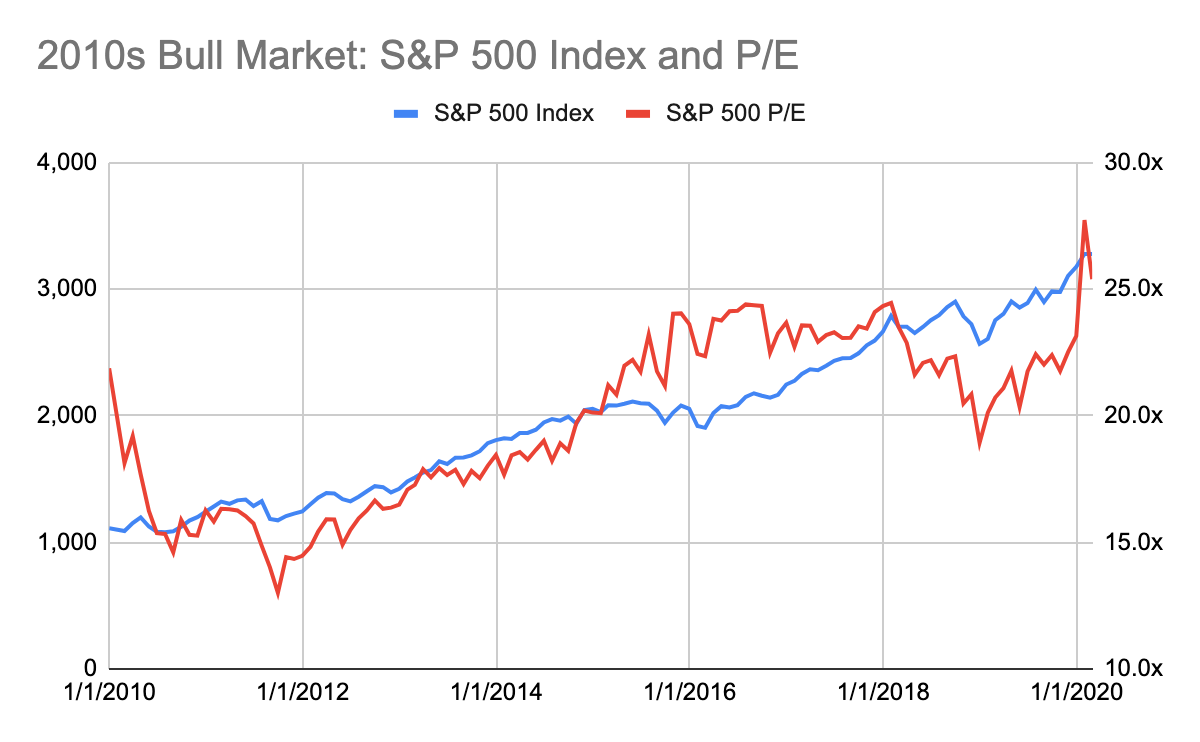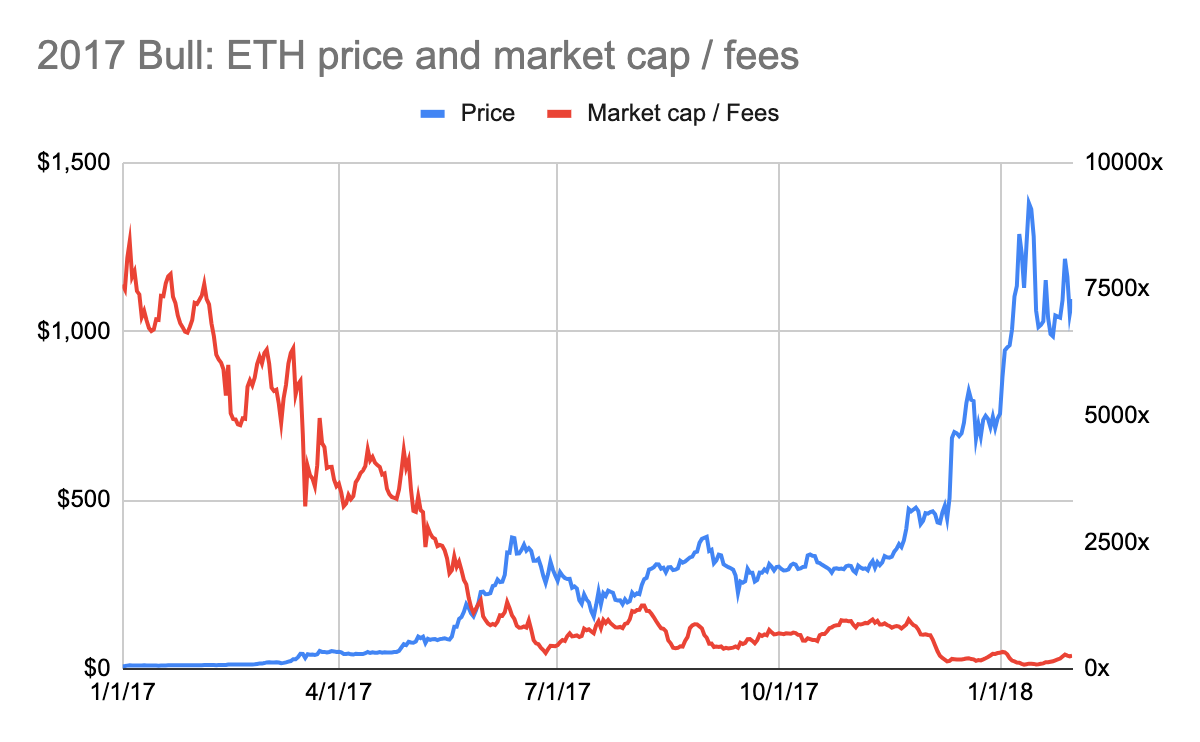Is there a relationship between Ethereum's price and income?
Title: 《Valuation Multiples: What are they good for?》
Author: SAM ANDREW, Crypto Clarity
Compiled by: MarsBit, MK
Are valuation multiples important in the crypto space?
Ethereum has the characteristics of a productive asset. It generates profits. These profits belong to the token holders. But is it viewed as a productive asset like stocks? Do valuation multiples of Ethereum affect the price of ETH?
Valuation multiples are a heuristic method for assessing the value of an asset. Google trades at 30 times earnings. Nvidia trades at 230 times earnings. If Google's current earnings remain unchanged for the next 30 years, it will take 30 years to recoup the investment in Google. If Google's earnings grow, the required years will be fewer. Relative to Nvidia, Google is "cheap" in terms of valuation. Entry valuations, such as 30 times versus 230 times, are not the only drivers of investment returns, but they are one of the important factors. Expensive assets, like Nvidia, already incorporate high growth expectations in their current valuation multiples. If they fail to meet these lofty expectations, prices will plummet.
Similar valuation multiples can be applied in the crypto space. Market cap divided by total fees is a crypto valuation multiple. Market cap represents the market's current view of the asset's value. Fees are the total revenue generated by the protocol. The revenue of a blockchain is akin to the profits it distributes across the network. Therefore, a blockchain's revenue and earnings multiples are the same.
What is the valuation multiple for Ethereum transactions?
The current rolling seven-day annualized fee multiple for Ethereum is 100 times. Since the summer of 2022, Ethereum's fee multiple has fluctuated between 25 times and 235 times (see the chart below: ETH price and market cap/fees since the 2022 low).

Source: CoinMetrics, artemiz.xyz
An Unexpected Relationship
The chart above shows an inverse relationship between ETH price and valuation multiples. The best time to buy ETH was at the end of 2022 when the price was around $1200. However, at that time, the valuation multiple for ETH was higher, around 200 times fees. By spring 2023, the price of ETH was close to $2000, but its fee multiple had dropped to 50-100 times.
The inverse relationship between price and valuation multiples is unexpected. Typically, when an asset's valuation multiple is lower, it is more cost-effective to buy that asset. Multiples are usually lower before an asset reaches a turning point. The market realizes that the asset is undervalued. As prices rise, valuation multiples also increase.
The chart below (2010s Bull Market: S&P 500 Index and Price-to-Earnings Ratio) illustrates the general relationship between price and multiples. It depicts the trend of the U.S. stock market bull market in the 2010s, up until the Covid outbreak. The S&P 500 index traded at about 15 times earnings at the beginning of this decade, averaging 18 times since 1928 and 26 times since 2000. In 2011, as the U.S. emerged from the global financial crisis with interest rates near historical lows, this turning point occurred. Since then, prices and multiples have begun to rise steadily.

Source: Macro Trends
So, what can we infer from Ethereum's multiples?
Do Ethereum's multiples indicate whether ETH is "cheap" or "expensive"?
How do "cheap" or "expensive" reflect in ETH's price performance? Is this a good buying opportunity like in the stock market?
Analyzing historical data can answer these questions.
Over five years, ETH's price rose from $10 to over $4000. This 400-fold price change makes it difficult to observe relationships in a single chart. Instead, different periods are highlighted to illustrate trends.
The bull market of 2017 highlighted the inverse relationship between multiples and prices. At the beginning of 2017, ETH's fee multiple reached an astonishing 7700 times (see the chart below: 2017 Bull Market: ETH Price and Market Cap/Fees). However, from the price trend, that was a good time to buy ETH, with a price around $10. Subsequently, ETH's price increased tenfold, and the multiple dropped to 100 times.

Source: CoinMetrics, artemis.xyz
The bull market of 2021 also exhibited the same trend. At the beginning of 2020, ETH's price was around $200, with a fee multiple of 650 times (see the chart below: 2021 Bull Market: ETH Price and Market Cap/Fees). ETH's price grew 24 times, while its multiple compressed to 22 times.

Source: CoinMetrics, artemis.xyz
Ethereum's bear market also displayed the same inverse relationship. At the beginning of 2018, ETH's fee multiple dropped to a low of 200 times, while its price approached a peak of $1000 (see the chart below: 2018 Bear Market: ETH Price and Market Cap/Fees). A few months prior, ETH's fees had exceeded 3000 times (see the chart above: 2017 Bull Market: ETH Price and Market Cap/Fees).

Source: CoinMetrics, artemis.xyz
Similarly, the time to sell was at the end of 2021 when ETH's fee multiple dropped to a low of 25 times, while its price reached a record $4000 (see the chart below: 2022 Bear Market: ETH Price and Market Cap/Fees).

Source: CoinMetrics, artemis.xyz
Conclusion
ETH's price and multiples exhibit an inverse relationship. History shows that it is best to buy ETH when its multiples peak and sell when its multiples hit a trough. This means buying ETH when its valuation multiples are highest and selling when they are lowest.
This is very counterintuitive.
This is different from how productive assets (like stocks) are traded.
What explains this peculiar relationship?
This counterintuitive conclusion can be explained in the following ways:
- The market is forward-looking.
- ETH is not valued based on fee multiples.
1. The market is forward-looking
Whether it's stocks, commodities, or crypto, the market is forward-looking. Prices reflect future expectations rather than past occurrences. One can understand this as a company's value being based on its future cash flows.
The market cap/fee multiple reflects Ethereum's fees at a specific point in time. The fees used to calculate the multiple are the total fees from the past seven days multiplied by 52 weeks. It does not reflect Ethereum's future fee potential. The fee numbers are not a forward-looking indicator.
Analyzing historical data confirms that the Ethereum market is forward-looking. During the bull market of 2017, Ethereum fees had already risen before the surge in Ethereum (see the chart below: 2017 Bull Market: ETH Price and Fees). Note that prices did not decline as rapidly as fees did at the beginning of 2018.

Source: CoinMetrics, artemis.xyz
A similar but weaker trend appeared during the bull market of 2021. By May 2021, prices had already risen before the corresponding increase in fees (see the chart below: 2021 Bull Market: ETH Price and Fees). However, in the summer of 2020, fees nearly doubled without a corresponding increase in ETH prices. Additionally, at the beginning of 2021, the growth in fees led to an increase in ETH prices. The first turning point may have been due to Covid. In the summer of 2020, people were in lockdown. DeFi applications experienced explosive growth. For this reason, user spending on Ethereum fees increased. However, the investment community did not pay attention to the crypto space.

Source: CoinMetrics, artemis.xyz
The evidence that ETH prices rise in advance to accommodate the growing Ethereum fees is clearest during bull markets. This relationship has neither been disproven nor confirmed during periods of ETH price decline or sideways movement. For brevity, we have omitted charts of ETH prices and fees during bear markets and sideways markets.
2. ETH is not valued based on fee multiples
The market may not value Ethereum based on fee multiples. If the market did so, then ETH's price and fee multiples should move in sync to some extent. The logic should be that lower multiples often imply a more attractive entry price, not the opposite.
Ethereum's fee multiples fluctuate wildly, tending toward higher valuation multiples. Since 2016, Ethereum's multiples have ranged from 10 times to 8800 times. Since 2021, this range has narrowed to 20 times to 235 times. Valuation multiples remain relatively high.
Ethereum possesses characteristics of productivity, commodity, and value storage. The valuation of productive assets is based on earnings multiples. However, commodities and value storage assets do not follow this. It is difficult to rationally explain ETH's valuation through fee multiples, which may indicate that ETH is viewed more as a value reserve asset rather than a productive asset.
However, this raises a complex question…
If ETH is not valued as a productive asset, then why does the price react in advance to the growth of fees?
Fundamentally, it shouldn't. After all, if ETH is a value reserve asset, then the growth of Ethereum's fees should not significantly impact its valuation.
But fees do indeed affect prices.
How much of an impact?
It's hard to say. ETH prices are influenced by multiple variables, including macro factors, regulation, and competition. It is impossible to isolate different variables to determine which has the greatest impact on prices.
……and how I reconcile these issues
In the crypto space, and specifically regarding Ethereum, fundamentals, such as fees, are indeed very important. Fundamentals determine the health and prospects of the network. For Layer 1 blockchains, fundamentals can only do so much in terms of valuing the network. Much of a blockchain's value lies in its monetary nature. Its ability to serve as a value reserve and value transfer. Its capacity to secure the network. Protocols and applications built on Layer blockchains rely more on their productive asset attributes, as explained in "Token Value Creation: Funnels into one thing."
Therefore, you cannot derive ETH's price from trading multiples. Ethereum's "cheap" or "expensive" multiples do not indicate much. But Ethereum's metrics, especially its fees, drive price fluctuations.
Stay curious.









